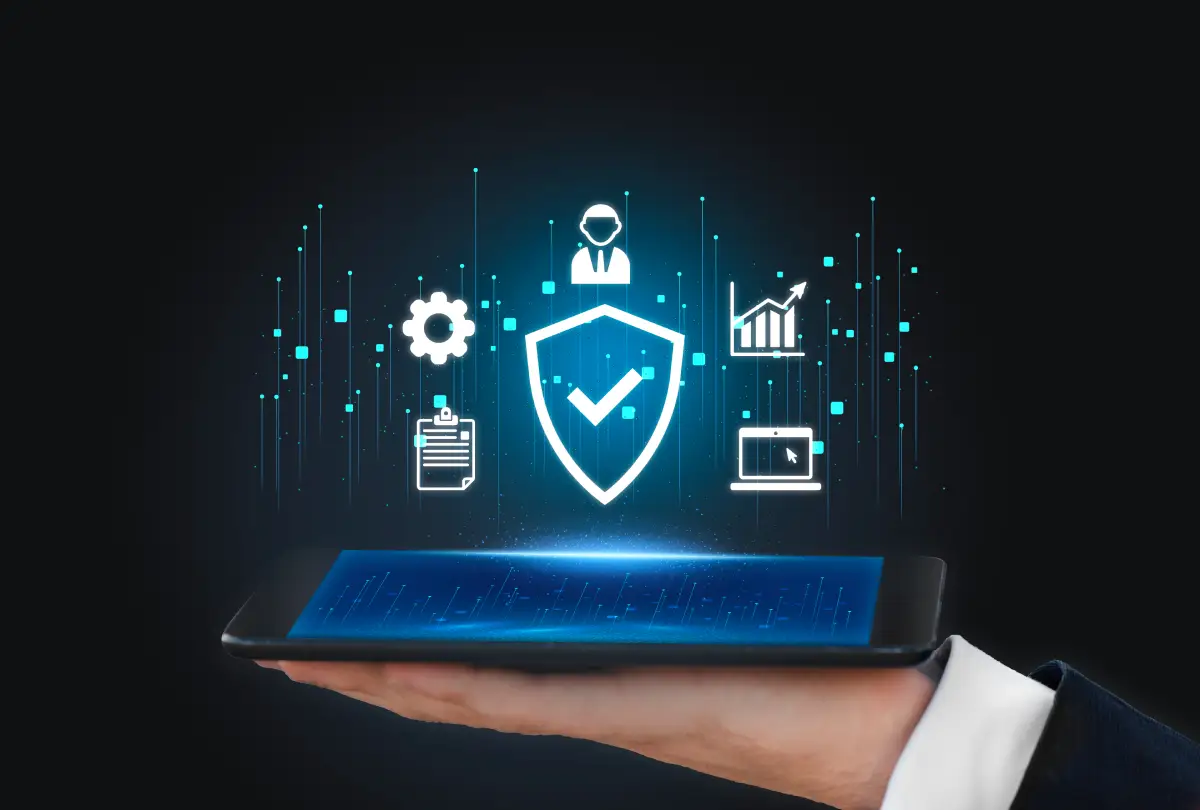Secure Your Business with Premier Cybersecurity Consulting
In an online world that’s constantly evolving, threats to your organization’s cybersecurity are becoming more sophisticated and relentless. mtds stands at the forefront of this battleground, offering unparalleled cybersecurity consulting services designed to protect startups, SMEs, public sector entities, private corporations, and educational institutions. With an unwavering commitment to safeguarding critical data and infrastructure, our mission is clear: Assess risks, ensure protection, and operate with confidence.
Tailored Security Strategies
Recognizing the individuality of each organization, we tailor our cybersecurity solutions to meticulously align with your specific needs and objectives. This bespoke approach ensures that whether you’re operating within the realms of finance, banking, insurance, or the semi-public sector, our strategies are designed to address your unique challenges and ambitions with precision. Our commitment is to provide you with a customized security framework that not only protects but also enhances your operations in your specific industry

Advanced Cyber Solutions
By leveraging strategic partnerships with industry giants such as Check Point and Fortinet mtds proudly offers cutting-edge cyber solutions that stand at the forefront of technology. Our comprehensive suite of services is meticulously designed to meet the highest standards of security, providing unparalleled support for the most sensitive and critical missions. Catering to the demanding requirements of defense, intelligence, and civilian agencies, our solutions are tailored to handle immense scale and complexity, ensuring that our clients are equipped with the robust security infrastructure they need to navigate the evolving digital landscape.

Rapid Response and Recovery
Our comprehensive and vigilant monitoring system is designed to ensure that responses to any cyber events are not only swift but also highly effective, thereby minimizing potential impacts on your operations. By leveraging our methodologies, tools, and strategies (MTDS), you have the capability to recover from cyber incidents rapidly. This resilience allows your organization to emerge stronger and more robust from any cyber adversity, ensuring continuity and security in an ever-evolving digital landscape.

Offerings and services
Cloud and Infra Security
Empowering secure cloud operations with proactive risk management for guaranteed success.
Data Protection
Safeguarding your business value through secure information and compliance assurance.
Attack and Penetration
We Fortify Your Digital World Against Vulnerabilities
Managed Security Services
Enhance, scale, and secure your operations with our expert-led services.
Application Security
Securing Business Success: Embed Security in SaaS, Enterprise, and Custom Applications.
Network security
A Shield Against the Digital Siege: we protect Your Online network.
FAQ
Ready to Transform
What is cybersecurity, and why is it important?
Cybersecurity is essential for defending computer systems, networks, and data against theft, harm, or unauthorized entry. It plays a critical role in securing sensitive data, preserving privacy, averting financial losses, and shielding vital infrastructure from cyber threats.
What is a Cyber Attack?
Cyber attacks typically unfold in phases, aiming to steal data, disrupt networks, or damage devices. First, attackers scan for vulnerabilities. Next, they begin the compromise. Finally, they execute the attack.
Types of cyber attacks
Social engineering
This concept covers a range of harmful actions aimed at exploiting human errors, tricking people into revealing sensitive information, spreading malware, or allowing access to secure platforms.
Phishing
Phishing, a form of social engineering, is highly effective as it often masquerades as a message or email from a trustworthy source. Typically, attackers aim to install malware or obtain sensitive data such as credit card numbers and login details.
Malware
“Malicious software,” encompassing spyware, viruses, worms, and ransomware, infiltrates systems upon a user’s interaction with hazardous links or emails. Once embedded, these malicious entities can restrict access, impair systems or devices, and harvest sensitive data, ultimately aiming to extort money.
SQL Injection
Cyber criminals inject malicious code into vulnerable servers and applications using Structured Query Language to gain access to sensitive data and perform commands or similar actions that the user didn’t request.
Man-in-the-Middle Attack
Cyber criminals position themselves between two legitimately communicating parties to disseminate malware. This malware allows the attacker to access a user’s browser and intercept the data transmitted. Once they gain control, these attackers can reroute users to counterfeit websites that mimic the appearance of the intended destination, enabling them to steal or alter information.
Denial of Service (DoS)
These attaques inundate servers or networks with concurrent requests, generating excessive traffic and preventing the processing of legitimate requests. When multiple devices are compromised to execute attacks on the target, this is referred to as Distributed Denial of Service (DDoS).
Advanced Persistent Threats
Commonly referred to as Domain Name System tunneling, Advanced Persistent Threats (APTs) employ sophisticated and ongoing tactics to infiltrate a system, enabling the attacker to maintain presence within it over an extended period.
How can I protect my business from the prevalent vulnerabilities?
To protect your enterprise against vulnerabilities, it is imperative to implement a comprehensive cybersecurity strategy. This strategy must include regular software updates to address security breaches, the utilization of robust, unique passwords along with multi-factor authentication for improved access control, and training for employees to recognize phishing and social engineering attempts. Furthermore, an investment in a reputable cybersecurity solution that provides real-time threat detection and response will significantly enhance your protective measures. Additionally, the execution of periodic security audits and vulnerability assessments is crucial for the prompt identification and rectification of potential risks. By adhering to these practices, your business will be well-equipped to navigate the constantly evolving cyber threat landscape.
Who Needs Cyber Security?
Certain sectors, such as healthcare, finance, and education, face a higher risk of cyber threats due to their business’s inherent characteristics. However, it’s imperative that all organizations and companies implement robust mitigation strategies to safeguard their networks and the sensitive information of their customers.
What makes Cybersecurity a current priority?
Since the first computer worm in 1971, highly publicized cyber attacks over the last 50 years have cost businesses globally trillions, highlighting the critical need for strong cyber security. The COVID-19 pandemic has increased these risks, with more remote work and the growing Internet of Things (IoT) making cyber threats more likely. Cyber criminals are constantly improving their tactics, taking advantage of the biggest cybersecurity weakness: human error.
As more devices connect to wider networks and more software, the need for advanced cyber security measures has never been greater. Businesses of all sizes must protect sensitive customer data with sophisticated defenses against cyber threats.
What Are Examples of Cyber Security?
In today’s era, characterized by the increasing frequency, sophistication, and boldness of cyber attacks, businesses face unprecedented pressure to safeguard their data. A comprehensive cyber security strategy is essential, encompassing a multi-layered approach that integrates tools, risk management techniques, advanced technologies, and industry best practices.
Network Security
Manages incoming and outgoing connections to block threats from entering or disseminating through the network. Essential components of network security may encompass antivirus software, antispyware tools, and a network firewall, which regulates traffic according to predefined security configurations and permissions.
Application Security
Today’s applications are more accessible across a wide range of networks, software, and devices than ever before. Implementing strong security measures such as mandatory robust user passwords, antivirus software, firewalls, and encryption services is most effective when done prior to the application’s deployment.
Information Security
A vital component of overall cyber security, Information Security (InfoSec) involves the strategies and tools dedicated to safeguarding sensitive data against alteration, disruption, and destruction. It is anchored in three fundamental principles: confidentiality, integrity, and availability, ensuring that data remains secure, accurate, and accessible when needed.
Cloud Security
Today’s businesses demand “always on” connectivity, necessitating advanced strategies to safeguard their networks. Cloud security emphasizes developing and hosting secure applications, ensuring data recovery, protecting storage and networks from cyber threats, managing identity and access (IAM), and minimizing human errors that could lead to data breaches.
Data Loss Prevention (DLP)
DLP (Data Loss Prevention) software tools oversee and manage endpoint activities, scrutinize data flows across networks, and secure data whether it’s stored, in transit, or in active use. Upon detecting a security breach, these systems immediately notify IT professionals and initiate encryption protocols to shield sensitive information from being compromised by malicious actions or accidental mishandling.
End User Education
A crucial and economical measure for protecting sensitive information involves conducting cybersecurity training for internal teams. This training is designed to enhance their understanding of their responsibilities in securing devices, managing network security, and recognizing indicators of malicious activities.
What categories of technology are typically employed in Digital Transformation initiatives?
Digital Transformation involves a wide range of technologies designed for different functions. These technologies are engineered to scale effectively, improve data integrity, increase efficiency, provide immediate reporting and data analysis, and strengthen organizational development through further automation and enhancement of business processes. Examples of these technologies include:
- Artificial Intelligence/Machine Learning
- Automation and Workflow
- Compliance & Security
- Data Management & Integration & migration
- Infrastructure and Cloud
- Reporting, Planning, and Data Analytics
Will Digital Transformation solutions replace my employees ?
No, The primary aim of Digital Transformation is to empower individuals in various operational domains to engage in tasks that contribute value. While technology can potentially automate repetitive tasks, its purpose is not to substitute human presence. We firmly assert that technology serves as a complement and aids individuals in their organizational endeavors, as it cannot supplant the unique human capacities for creative, critical, strategic, and collaborative thinking.
Which industries does Digital Transformation influence ?
The influence of Digital Transformation varies across industries, influenced by several key factors:
- The industry’s reliance on technology and the rapidity of technological advancements.
- The specific technologies employed by the industry to streamline business operations.
- The level of stakeholder reliance on technology, including customers, suppliers, and employees.
What are some signs that suggest it's the opportune moment to commence Digital Transformation?
The optimal time to initiate transformation depends on multiple factors, with early action frequently being beneficial. Factors to consider include the organization’s readiness, industry dynamics, market conditions, financial health, long-term strategies, and compliance with regulatory requirements. These elements are crucial in determining the right moment to start this journey:
- Rapid business growth surpassing current financial and accounting capabilities.
- Mergers or divestitures altering operational landscapes.
- Implementation of new systems necessitating organizational adjustments.
- Identification of inefficiencies hindering operational efficiency.
- High turnover rates impacting workforce stability.
- Disparities across multiple locations in standard practices.
- Initiatives aimed at staffing optimization or cost reduction.
- Timely and accurate access to operational and financial data for informed decision-making.
- Aspirations to scale operations and establish industry leadership.
How much time is typically required for Digital Transformation?
Every digital transformation journey is unique, necessitating a bespoke strategy aligned with the unique goals and aspirations of the organization. Recognizing the extensive time investment required is crucial, as these initiatives often span several months or more. Digital transformation is not a one-off project but an ongoing evolutionary journey, encompassing numerous sub-projects critical to achieving the larger strategic objectives. With technology continually advancing, organizations must adapt persistently to stay competitive. This may include embarking on new digital transformation efforts to sustain the competitive edge gained from initial endeavors. Therefore, it’s critical to emphasize the early phases of digital transformation, as they lay the foundation for sustained long-term success.
How can I contribute to my organization's success in Digital Transformation?
Success in digital transformation requires a mix of dedicated internal leadership and expert external advice. Key personnel from departments such as IT, finance, operations, HR, and beyond need to lead the charge, driving teams forward in these endeavors. Leadership must cultivate an environment that welcomes the changes brought by digital transformation. At the same time, tapping into the expertise of digital transformation specialists outside your organization is critical. These professionals contribute best practices and invaluable hands-on experience, addressing challenges that may surpass the capabilities or capacity of your internal team. This approach is fundamental in navigating the complexities of digital transformation and achieving lasting success.
Ready to Reinforce Your Defenses?
Elevate your security with MTDS's advanced cybersecurity services and secure a prosperous future.




















